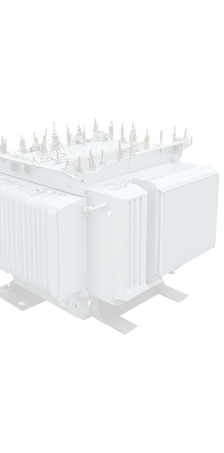Voltage fluctuations are one of the most common challenges faced in power distribution systems. Whether in industrial, commercial, or even residential environments, unstable voltage can have a significant effect on the performance and lifespan of electrical equipment—especially transformers. When left unmanaged, these fluctuations directly undermine transformer efficiency, leading to overheating, energy loss, insulation failure, and eventual breakdown.
To maintain reliable power flow and system performance, it’s essential to understand how voltage instability affects your transformers and how to choose the right one for your specific application.
In this post, we’ll explore how voltage variations influence transformer operation, the dangers they pose, and how to select transformers that can handle these fluctuations while maintaining high efficiency.
Understanding Transformer Efficiency
Before diving into voltage issues, let’s clarify what transformer efficiency means. A transformer’s efficiency is the ratio of its output power to its input power. Ideally, the transformer should convert electrical energy with minimal losses.
In real-world conditions, efficiency is impacted by:
- Core losses (hysteresis and eddy current losses)
- Copper losses (I²R losses in windings)
- Load variability
- Voltage stability
When voltage fluctuates, especially outside a transformer’s designed input range, the losses increase—reducing overall efficiency and increasing energy costs.
How Voltage Fluctuations Affect Transformers
1. Increased Core and Copper Losses
When voltage rises above the rated limit, core losses increase exponentially. These losses lead to overheating of the transformer’s magnetic core and insulation. On the other hand, voltage drops cause the transformer to draw more current to maintain the power output, increasing copper losses.
Both conditions strain internal components and reduce transformer efficiency over time.
2. Reduced Lifespan of Insulation
Frequent voltage surges or drops cause the internal temperature of the transformer to fluctuate. These thermal variations degrade the insulation, leading to partial discharges and eventual breakdown. For used electrical transformers, insulation is often already aged, so the risk becomes even higher.
3. Inconsistent Load Handling
Voltage fluctuation affects the stability of output voltage delivered by the transformer. In environments with sensitive equipment or machinery, this inconsistency can cause downtime, malfunctions, or safety risks. A transformer that cannot maintain voltage stability under fluctuating input is inherently inefficient and unreliable.
4. Overheating and Risk of Failure
Prolonged exposure to under-voltage or over-voltage conditions can result in the overheating of windings, leading to thermal failure. Without proper protection and selection, this could lead to permanent damage or even fire.
That’s why selecting transformers with robust design, modern insulation, and overload protection is essential for long-term transformer efficiency.
Choosing the Right Transformer for Maximum Efficiency
Selecting a transformer that can perform well even under voltage instability is the key to safeguarding both performance and reliability. Here’s what to look for:
Voltage Regulation Capability
Transformers with tight voltage regulation can maintain a stable output even when input voltage fluctuates. This helps keep loads running optimally and improves transformer efficiency by minimizing losses caused by overcompensation.
Use of Tap Changers
Tap changers allow transformers to adjust their voltage ratio based on system requirements. This feature helps maintain consistent output and ensures the transformer adapts to varying voltage conditions without excessive strain.
If you’re evaluating used transformers, confirm that the tap changer (manual or automatic) is in good working condition.
Quality of Windings and Core Material
High-grade copper windings and low-loss core materials (like amorphous steel) help reduce energy loss and support better performance during fluctuations. Units that have been upgraded through transformer rewinding also offer better resilience to electrical stress.
Look for Refurbished or Surplus Options
Professionally refurbished or surplus transformers can be equipped with newer insulation, rewound coils, and added protection features to ensure reliable operation—even under fluctuating voltage conditions.
JJ Transformers offers a wide range of refurbished units tailored to meet your voltage and load requirements while maintaining peak transformer efficiency.
Purchase from a Trusted Source
If you’re looking to buy used transformers, always choose a reputable transformer company that tests every unit for voltage regulation, efficiency, and thermal performance.
Suppliers who also offer complete transformer services can support you beyond the sale with routine maintenance, insulation testing, and protection system upgrades.
Additional Ways to Improve Transformer Efficiency During Voltage Fluctuations
Even with the best transformer, external protection and maintenance strategies play a major role in preserving performance:
- Voltage Stabilizers: Install automatic voltage regulators upstream to buffer fluctuations.
- Surge Protection Devices: Prevent damage from spikes caused by switching or lightning.
- Routine Testing: Regular load testing and infrared thermography can detect early inefficiencies.
- Preventive Maintenance: Work with providers that offer transformer services to keep your unit running optimally.
Final Thoughts
Voltage fluctuations are an unavoidable reality in most power systems—but the damage they can do to your transformer is not. By understanding how these fluctuations affect transformer efficiency, and selecting equipment designed to handle them, you can ensure reliable performance, reduce downtime, and extend the lifespan of your investment.
Whether you’re exploring transformers for home or considering an industrial upgrade, the key lies in choosing the right design, sourcing from trusted suppliers, and maintaining your system with expert care.
Protect your operations from inefficiencies and failures. Choose smarter, maintain better, and get the best out of your transformer—no matter the voltage conditions.



